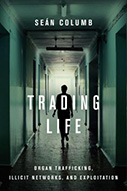Trading Life: Organ Trafficking, Illicit Networks And Exploitation

Author: Sean Columb
Publisher: Palo Alto, CA: Stanford University Press, 2020. 224p.
Reviewer: Frederike Ambagtsheer | August 2021
Trading Life: Organ Trafficking, Illicit Networks and Exploitation by Seán Columb is a timely and thought-provoking book, based on long-term fieldwork that offers novel insights into one of the world’s most hidden and neglected crimes — the human organ trade.
Columb’s research fills critical knowledge gaps on the exploitation of migrant kidney sellers, the modus operandi of organ trade networks, and the organ trade’s links to human smuggling. His findings are based on 63 in-depth interviews carried out in Cairo, Egypt. His respondents include organ sellers, organ recipients (patients), transplant professionals, law enforcement officials, NGO staff, and the largest published group of interviewed brokers to date (seven respondents). He describes, in detail, how organ trade networks operate and how they intersect with legitimate (transplant) institutions, thereby challenging the popular belief that the trade operates as an underground crime that is far-removed from transplant medicine.
Columb traveled to Egypt multiple times from 2014 until 2020, which enabled him to follow-up on previous interviews, corroborate earlier findings, and establish trust with his respondents. Crucially, his research enabled him to observe the organ trade becoming more violent as a result of Egypt’s new and more stringent anti-organ trafficking legislation. In addition, he is the first researcher to expose how anti-organ trafficking, anti-smuggling and anti-migration -laws and policies exacerbate the vulnerabilities of irregular migrants, inducing their risk to organ sales and exploitation. Columb has given organ trafficking victims a voice, but contrary to current discourse, his work goes beyond merely describing their complaints. The interview excerpts presented throughout the book aim to portray its central thesis: that vulnerability to organ sales, smuggling and exploitation arises from coercive state policies and the precarious context of having an illegal status. Crimes such as organ trafficking will continue as long as irregular migrants are not given the right to work legally. Columb’s findings make his work the most important and contemporary book that has been published on the human organ trade to date.
The book’s aims (Chapter 1) are to demonstrate how law and policy produce vulnerability to exploitation in organ markets, and to explain the theoretical and practical implications of the prevailing law enforcement model in response to organ trade. Columb further asks the following questions: Why do people sell organs? How is the trade facilitated and organized? How do law and policy produce vulnerability? How do social experiences of exploitation differ from legal exploitation as defined in the UN Palermo Protocol? How do organ markets emerge in a particular context and to what extent is the trade controlled by organized crime groups? The book is divided into 2 parts: Chapters 2-4 cover the trade in Egypt as an informal activity before the law prohibiting organ trade was passed. Chapters 5-6 cover the organ trade as an organized criminal activity following the prohibition of organ sales.
Columb begins by outlining the international, normative status quo — organ trade is prohibited globally, yet prohibition neither prevents the trade’s proliferation nor protects organ sellers. He particularly criticizes the prohibition of ‘trafficking’, positing that the trafficking label has been used to create and support a criminal justice system that reproduces the conditions of exploitation that it claims to prevent. The framing of organ trade as a trafficking problem has diverted attention away from the trade’s structural causes and its embeddedness in the transplant industry. Furthermore, ‘organ trafficking’ is used to justify increased border controls and harsher migration and smuggling policies which only increase the level of harm inflicted on organ sellers.
In Chapter 2, Columb introduces Egypt’s history and culture of organ donation and transplantation. Quoting Egyptian transplant professionals, he points out that contrary to internationally proclaimed norms, it is considered unethical in Egypt not to pay organ donors. The trade in living donor kidneys, he posits, is tacitly accepted as an unregulated market solution to organ scarcity, and is rationalized as a mutually beneficial transaction. However, because Egypt allowed foreigners to travel to Egypt for commercial transplantations, the country acquired a reputation as a ‘transplant tourism hotspot’. Concerned with its new reputation and under the pressure of professional transplantation societies, Egypt established a law in 2010 prohibiting the sale and purchase of organs and introducing severe criminal penalties. Columb explains that rather than banning organ sales, this law has shifted recruitment towards (mainly Sudanese and Eritrean) irregular migrants as the major suppliers of organs in Egypt. What’s more, because the law criminalizes organ sales, it becomes unclear when a donor is a perpetrator of an organ sale, or a victim of human trafficking. This ambiguity is particularly problematic for irregular migrants who are excluded from state protection and risk prosecution if they report harms.
In Chapter 3, Columb focuses on the social organization of the organ market as he first encountered it in Cairo in 2014. Contrary to popular depictions of the organ trade as an underground organized crime, Columb describes the trade as an informal collection of loose networks that intersect with private and public hospitals, clinics, and tissue typing labs. These ‘hubs’ proliferated after the 2010 anti-organ trafficking law was enacted. Here, Columb introduces his first interviews with migrant kidney sellers and organ brokers. He describes their recruitment methods, negotiation processes, profit distribution flows and ‘organ laundering’ tactics (a term first introduced by Manzano, et al.), meaning that illegal transplants are concealed and rendered legitimate, through a network of intermediaries (Manzano, Monaghan, Potrata, & Clayton, 2014).
Chapter 4 presents the social, legal and political factors that compel migrants in Cairo to sell their organs. Columb emphasizes that it is structural exploitation that induces migrants’ organ sales. Because acquiring a legal status (or a work permit) is next-to-impossible for irregular migrants, organ selling becomes a survival strategy. This vulnerability reduces their bargaining position. All organ sellers that Columb interviewed were also victims of labor (and sometimes sex-) trafficking, working long hours for insufficient wages. Columb highlights the state’s indifference to the welfare of immigrants as a common theme and points out that procuring organs from migrants raises less suspicion. The interviewed organ sellers were disillusioned with the lack of support from the UNHCR and other governmental and non-governmental organizations, and reported a complete lack of trust in local authorities. Because organ sales are criminalized, none of the interviewed sellers were able to safely report the harms inflicted upon them.
Chapter 5 covers the author’s fieldwork from 2017 until 2020. It examines the impact of stricter laws and policies as a result of a joint EU-Africa strategy to fight irregular migration, organized crime, smuggling and human trafficking. More specifically, Columb explores the impact of these laws and policies on the organ trade, and he exposes the links between human smuggling and trafficking and organ sales. Columb points out that stronger legislative responses to organ trade have pushed the trade further underground, increasing the facilitative role of brokers. Tighter migration controls have expanded the market for smugglers and traffickers, have made migration routes more hazardous, and have pushed irregular migrants to further extremes. He demonstrates how the crackdown on human trafficking has come at the expense of safeguarding the human rights of migrants. Failure to protect refugees has produced more demand for smuggling services and increased the dependency of migrants on illicit networks. These networks now involve select members of embassies who provide ‘approval of kinship’ forms that allow illicit organ donations in return for monetary compensation. Kidney sales in turn are used as payments to facilitate smuggling into Europe. He concludes that the coercive power of state policies enables criminal entrepreneurs to exploit the inability of migrant populations to maintain a livelihood.
The new law banning organ trade in Egypt has not been followed by better enforcement. Yet, the perceived risk of prosecution has made the organ trade more organized, secretive and violent. Columb notes that compared to organ sellers interviewed in 2014, the respondents he interviewed between 2017 and 2020 reported higher levels of physical abuse, intimidation and exploitation. He reports a breakdown in trust between organ sellers and brokers. Because organ sellers no longer receive the promised amounts for their kidneys, there is a reluctance to sell, leading to more violent means of recruitment. A ground-breaking finding is that illicit transplants have now moved from clinics and hospitals to apartments, which further increases the risk of physical harms. High-ranking government officials actively profit from these transplants. Criminal groups do not fear arrest because they pay protection money to police and government officials.
While Columb concludes that prohibition has had negative consequences for organ sellers, he veers away from proposals advocating a regulated organ market that allow payments for organs. He warns that allowing payments would nonetheless create an economic, exploited underclass across the Global South. He is critical of international treaties and declarations, in particular the 2015 Council of Europe Convention against Trafficking in Organs, that fail to protect organ sellers from criminal liability. He opposes the writings of prominent scholars who claim that organ markets create an underclass. Organ markets, Columb contends, do not create an underclass, but are a condition of it. Thus, if we are concerned about the well-being of organ sellers, world leaders should address the policy decisions that leave people vulnerable to exploitation in the first place.
Columb is the first researcher to highlight the role of the transplant industry in sustaining organ trade. He posits that the commercial expansion of the transplant industry and the emergence of the organ market are interlinked. He contends that if policy-makers are serious about reducing the commercial demand for organs, transplantation needs to be uncoupled from economic incentives and restructured to accommodate domestic needs. This would involve a restructuring of our health systems. Columb also doubts whether countries should invest in expensive transplantation technologies at the expense of (preventative) strategies such as provision of clean drinking water and sanitation.
To reduce the harm inflicted on organ sellers, Columb advocates for decriminalization of organ sales. He contends that the negative consequences of criminalization illustrated by studies on the drug trade and prostitution reform support an argument for further decriminalization with regard to other illicit markets, including the organ trade. While decriminalization will not eliminate illegal markets and criminal networks, it would provide formal recognition to persons with an illegal status. Decriminalization would at least increase non-violent means of dispute resolution, reduce stigma and open up the potential for dialogue and legal reform beyond criminal law. Decriminalization should be combined with providing labor for refugees according to internationally recognized standards, and creating more legal avenues for refugees and economic migrants.
Columb has succeeded in writing a book that is accessible and understandable for a broad audience, including law -and policy makers, scholars, teachers and students with an interest in migration issues, exploitation, trafficking, smuggling and illicit networks. It is also insightful for those aiming to understand what happens to a market once it becomes illegal. Scientifically, Columb has provided essential building blocks that help to advance knowledge of the organ trade, both empirically and theoretically. His insights have opened up new methods of approach, demonstrating the need to incorporate corporate crime perspectives, crimmigation, and legal/state-induced forms of exploitation to the study of the organ trade. Columb’s book should be a core resource for anyone studying this crime.
Erasmus MC Transplant Institute, University Medical Center Rotterdam, Department of Internal Medicine, Rotterdam, the Netherlands
Reference
Manzano, A., Monaghan, M., Potrata, B., & Clayton, M. (2014). The invisible issue of organ laundering. Transplantation, 98(6), 600-603.


